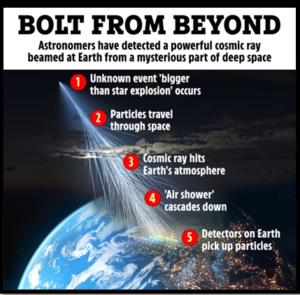AMATERASU
Why in the News?
- A cosmic ray that has been dubbed ‘Amaterasu’ appears to have reached the earth from an empty part of the universe.
Source: TheSun
About
- In May 2021, Japanese scientist Toshihiro Fujii discovered a remarkably high-energy cosmic-ray event, which he named ‘Amaterasu,’ after the Japanese sun goddess.
- This cosmic ray, Amaterasu, is the second-highest-energy cosmic ray ever detected and was found by analyzing data collected between May 2008 and November 2021 by the Telescope Array Project in the U.S.
- Cosmic rays are energetic particles from space, including protons and alpha particles, and understanding them is crucial as they influence life on Earth.
- The energy of Amaterasu was measured at an astonishing 240 exa-electron-volt (EeV), making it about 40 million times more energetic than particles accelerated in the Large Hadron Collider (LHC).
- Ultra-high-energy cosmic rays (UHECRs) like Amaterasu, with energies greater than 1 EeV, are of particular interest. Cosmic microwave background radiation limits their propagation beyond certain distances in space.
- Amaterasu’s origin remains a mystery as it appears to come from an empty part of the universe, defying existing astronomical explanations. This discovery challenges the Standard Model of particle physics and suggests the possibility of unknown phenomena.
- In 1991, another high-energy cosmic ray, known as the “Oh My God” particle, with an energy of 320 EeV, was detected, and it remains the most energetic cosmic ray ever recorded.

 Source: TheSun
Source: TheSun

